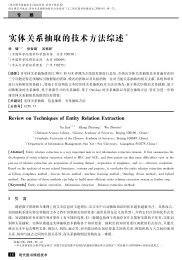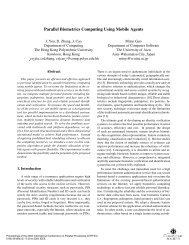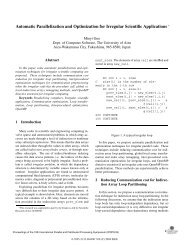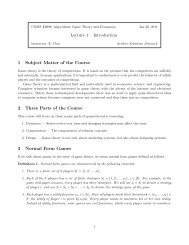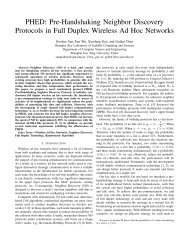Notes 4.pdf - Algorithmic Game Theory and Economics
Notes 4.pdf - Algorithmic Game Theory and Economics
Notes 4.pdf - Algorithmic Game Theory and Economics
Create successful ePaper yourself
Turn your PDF publications into a flip-book with our unique Google optimized e-Paper software.
COMS E6998: <strong>Algorithmic</strong> <strong>Game</strong> <strong>Theory</strong> <strong>and</strong> <strong>Economics</strong> Feb 10, 2011Lecture 4 – Nash’s Mixed Equilibrium <strong>and</strong> Brouwer’s Fixed PointInstructor: Xi ChenScribes: Barbara Kiskovski, Melanie Kambadur1 Nash EquilibriumLast week, we showed that every zero-sum, two-player game has a mixed equilibrium [Von Neumann,1929]. This week, we will prove that every game has a mixed equilibrium [Nash, 1950].To succinctly prove the existence of this mixed equilibrium, we will make use of Brouwer’s fixed pointtheorem:Theorem 1 (Brouwer’s Fixed Point Theorem). Given S ⊂ R n , where S is convex, bounded, <strong>and</strong> closed,every continuous map f : S → S has a fixed point x ∗ : f(x ∗ ) = x ∗ .1.1 Real-world Experiment: A MapIn order to better grasp the concept of Brouwer’s Theorem we will start by a real-world experiment. Westart by assuming that we have two copies of the same map, each with different scales. Every point onthe map corresponds to a geographic place. We now place the smaller map anywhere (<strong>and</strong> at any angle)on the larger map. We say x is a magic point if the geographic place it corresponds on the smaller mapis exactly the same as the place it corresponds on the larger one.Brouwer’s fixed point theorem then claims that no matter where we place the smaller map, as longas it is completely inside the bigger map, we will always be able to find a magic point.1.2 Existence of Nash EquilibriaNow we will use the Fixed Point Theorem to prove the existence of Nash equilibria. We begin with thefollowing definitions: We let G = (A, B) denote a two-player game, <strong>and</strong> let x ∈ ∆ m denote a mixedstrategy of player 1 <strong>and</strong> y ∈ ∆ n denote a mixed strategy of player 2.Definition 2. We define (x, y) to be a mixed equilibrium if x is a best-response with respect to y, <strong>and</strong> yis a best-response with respect to x.Definition 3. There are three equivalent definitions of best-response:1. x T Ay ≥ (x ′ ) T Ay, for all x ′ ∈ ∆ m ;2. x T Ay = max i∈[m] A i,∗ y;3. x k > 0 ⇒ A k,∗ = max i∈[m] A i,∗ y.1
We want to be able to define a continuous map f from G, which maps any pair (x, y) of probabilitydistributions to a new pair (x ′ , y ′ ) of probability distributions: f : ∆ m × ∆ n → ∆ m × ∆ n , <strong>and</strong> use ittogether with Brouwer’s fixed point theorem to prove the existence of Nash equilibria in G. We haveproven Nash’s Theorem if we can show that the map has the following properties:1. It must be continuous.2. If (x, y) is a fixed point of f, then it is a mixed equilibrium of G.We begin with the definition of f <strong>and</strong> proof of the first property.Proof. If (x, y) is already a Nash Equilibrium, we will map it to itself. If x is not a best response, thenwe replace it with a new x ′ . Similarly, if y is not a best response, we replace it with y ′ .Our strategy will be to decrease the probabilities of the ’bad’ rows which are not the best response<strong>and</strong> increase the probabilities of ’good’ (best response) rows: Letc i (x, y) = max (0, A i,∗ y − x T Ay)x ′ i =x i + c i (x, y)1 + ∑ j∈[m] c j(x, y)Note that c i is positive when playing row i is better than x.Similarly for player B:d i (x, y) = max (0, x T B ∗,i − x T By)y i ′ =y i + d i (x, y)1 + ∑ j∈[n] d j(x, y)This is clearly a continuous map since the numerator is a linear function, <strong>and</strong> the denominator is quadratic.Thus the map is continuous.Next we go back to prove the second property.Claim 4. (x, y) is a Nash equilibrium of G if it is a fixed point of f, meaning thatx i =y i =x i + c i (x, y)1 + ∑ j∈[m] c , ∀i ∈ [m] <strong>and</strong>j(x, y)y i + d i (x, y)1 + ∑ j∈[n] d , ∀i ∈ [n]j(x, y)Proof. Assume x is not a best response. Given the vector [A 1,∗ y . . . A m,∗ y], we know that one entry, let’ssay the first entry, must be larger than x T Ay. This implies that c 1 (x, y) > 0. Furthermore, another entryof the vector, let’s say the last entry, must be less than or equal to x T Ay. This implies that c m (x, y) = 0,which is a contradiction:x m > x m + c m (x, y)1 + ∑ j c j(x, y)Thus, we must have a mixed equilibrium for this two-player game.2
2 Brouwer’s Fixed Point Theorem [1911]We begin with a simple 1-dimensional space, where S = [0, 1] is the domain of the continous functionf : S → S.Proof. We want to show that ∃x ∗ s.t.f(x ∗ ) = x ∗ . If f(0) = 0, we know that our fixed point is 0. Otherwise,f(0) > 0. If f(1) = 1, we are finished with the proof because 1 is our fixed proof. Otherwise, f(1) < 1.Then, by the mean-value theorem, x ∗ above in the picture, that is, the intersection of f with x = y, mustbe a fixed point.2.1 Sperner’s Lemma in 1-dimensionThe proof for the 2-dimensional space is relatively more complex then the one for the 1-dimensionalspace. The original proof given by Brouwer was relatively long. However in 1928, Sperner came up witha better approach for this proof based on a parity argument. Instead of counting the number of objects<strong>and</strong> proving that the number of objects is positive, looking simply at the parity <strong>and</strong> proving that it isodd suffices. We will now give an alternative proof for the 1-dimensional case using Sperner’s Lemma:Lemma 5. Given n points on a line, a coloring is proper if the color of the first point is red <strong>and</strong> thecolor of n is green. If a coloring is proper, there exists an interval with different colors.Proof. Given an interval i = [i, i + 1], we let{1 if [i, i + 1] is red-greenRedGreen(i) =0 otherwise<strong>and</strong> letRedPoints(i) = number of red points in [i, i + 1].3
Then we will show thatn−1∑RedGreen(i) parity≡i=1n−1∑RedPoints(i) = oddi=1Observe that RedPoints(i) must be ∈ {0, 1, 2}. We will now claim that RedGreen(i) has the same parityas RedPoints(i) at any segment i = [i, i + 1]:Case 1: RedGreen(i) = 1 ⇒ RedPoints(i) = 1Case 2: RedGreen(i) = 0 ⇒ RedPoints(i) ∈ {0, 2}Since the parity is the same in the above cases, the sum of all the segments must have the same parity.Now, we just need to show that:parity ofn−1∑RedPoints(i) = oddi=1To do this, we look at a point i on the interval that is not an endpoint. If the point is red, we count oncefor segment [i, i − 1], <strong>and</strong> again for segment, [i, i + 1]. Thus, the total contribution of point i to the sumabove is even, <strong>and</strong> the parity of the sum of segments is not affected.Finally, we look at the two endpoints. We use the boundary condition (from the definition of a propercoloring) to find that the sum must be odd.2.2 Sperner’s Lemma in 2-dimensionsWe will now extend this simple argument to 2-dimensions. We start with a large triangle that we divideinto progressively smaller triangles. We then have Θ(n 2 ) small triangles for every n intervals. We saya 3-coloring is proper if the thee vertices of the big triangle are colored in different colors (red, green,blue). Additionally, the red-green side of the triangle must have only red or green points, the red-blue4
side of the triangle must have only red or blue points, <strong>and</strong> the green-blue side must have only green orblue points. We can now state Sperner’s Lemma:Lemma 6. If the 3-coloring is proper, ∃ a triangle which is a trichromatic triangle (an inner trianglevertices are colored with all three colors).To prove this, we will count the number of triangles, prove that number is odd, then it follows thatyou can always find at least one trichromatic triangle.Proof. For each small triangle △, we letTrichromatic(△) ={1 if △ is trichromatic0 otherwise<strong>and</strong>RedGreenSeg(△) = number of red-green sides of △ ∈ {0, 1, 2, 3}.First we show that∑Trichromatic(△)all△For any given △, we have the following two cases:same parity∼case 1: Trichromatic(△) = 1 ⇒ RedGreenSeg(△) = 1∑RedGreenSeg(△)all△case 2: Trichromatic(△) = 0 ⇒ RedGreenSeg(△) ∈ {0, 2}Now, we need to show that the parity of RedGreenSeg(△) is odd.Any segment inside the triangle is shared by two small triangles <strong>and</strong> so is counted twice. Thus, either 0or 2 is added to the sum, <strong>and</strong> the parity is unaffected.5
As a result the relevant segments are the ones on the boundary of the outer triangle. RedGreenSegscan only occur on the red-green side of the triangle, so the red-blue sides <strong>and</strong> the green-blue sides arenot useful either.The red-green segments can only occur on the red-green side of the triangle. As these can onlycontribute to a single triangle, <strong>and</strong> since the number of RedGreenSegs on the red-green side is odd (usingthe 1-dimensional Sperner’s lemma we just proved) we get the following, which concludes the proof:∑RedGreenSig(△) = oddall△6





